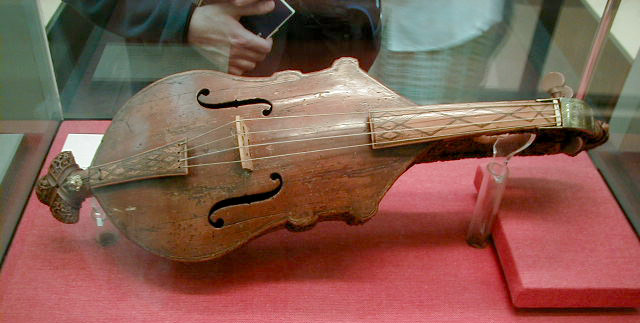The History of the Violin
Although it is believed that the Italian luthier Andrea Amati created the modern violin family around the year 1555, bowed stringed instruments were invented long before this date. For this reason, it can be helpful to think of the violin as an instrument that has evolved over time, rather than as a perfected product that was instantaneously invented.

While there are records of stringed instruments existing in Europe in the Middle Ages, it is thought that the first bowed, stringed instruments may have originated in Central Asia with instruments such as the morin khuur from Mongolia. These Central Asian instruments then travelled via trade routes to other parts of the world. Once instrument craftsmen in Europe became aware of these instruments and how they were made, they then created their own take on them, using traditional European crafting techniques.
Many different kinds of stringed, bowed instruments evolved in the 16th century in Europe, which has caused some contention about certain aspects of the violin family's history. It is thought that perhaps Andrea Amati did not create the first modern violin, and that it was instead created in Brescia earlier in the 16th century. One thing we can be certain about however is that there were a wide variety of different stringed instruments around in the 16th century that the modern violin and its family eventually evolved from - including the lira da braccio, a bowed stringed instrument much like the violin that was popular in the Renaissance period. The oldest surviving violin is named Charles IX, which was made by Andrea Amati in 1564, which in some respects supports the theory that Amati did indeed create the first standard modern violins, or at least provides physical evidence to justify this claim.
The violin became a popular instrument in Europe with both low class and high class instrumentalists due to its small size, versatility, and its sweet, melodic tone. The violin family eventually became more popular than its close rivals the viol family because the violin instruments had an increased sound projection that was better suited to larger concert venues.
During the late 18th and early 19th Century, the violin underwent some significant technical changes. The fingerboard of the violin was made longer, and it was also set at more of an angle to support the tension of the strings being increased. The increased tension of the strings, coupled with the change in the fingerboard, resulted in the violin having an increased range and sound projection. Older violins were adapted to these new specifications by luthiers (sometimes using techniques that significantly impaired the original instrument), and newly made violins were crafted using this new style. It is unknown exactly when and by whom these changes were initially made.
As the popularity of the violin grew, more violins were produced and the violin was adopted into many different styles of music. Violin players developed new playing techniques to complement new genres, and the violin was sometimes modified slightly to fit the needs of the new genre. The violin became a key instrument used to play traditional songs in Celtic, Irish, gypsy, and Hungarian music, and was later used to play country/western, bluegrass, blues and jazz as these genres emerged over time.
The Violin Today

The violin is now one of the most popular instruments in the world. Old violins tend to be sought after over mass produced factory violins by intermediate and advanced players because of their superior craftsmanship, resonance, and because the tone and timbre of the violin is thought to mature over the lifetime of the instrument. The most famous violin maker is the 'Golden Age' luthier Antonio Stradivari, whose violins now sell for millions of dollars.
Violins that are made today can produce sound electronically by using amplifiers and microphones, eliminating the need for a sound box. Fully electric sound produced by violins can be distorted through amplifier settings to create different tonal qualities altogether - further diversifying the capabilities of the instrument.
The violin has ultimately evolved to be a very versatile instrument, and a violinist now has numerous career options and genres to explore. While violins may be famed for their classical origins, there are many amazing blues, Celtic, country, bluegrass and popular violin players flourishing in these different musical environments- which is one of the many reasons why the violin is such an exciting instrument to learn!












idk
h
h
h
h
idk
idk
-_-
-_-
-_-
nice
nice i like it this will help me do my project
??
you people are weird
This iste was very helpful for my project but it could use a couple more subheadings
This site holds a lot of information that I could use on my project for my class. If only there were more headings to sort where each topic of information is, then my work would have deduced.
Person
This Site SUCKS
it doesnt tell enough about the violin
ok yes
Beware the violas!
I play the viola and it's much better!
Thanks!
This actually helped me a lot. I do play the violin, and this gave me a lot of great information. Keep up the good work! Don't listen to these obviously entitled people.
although it was a great website , there are still other fabulous sites . say musica-barroca.com/en/the-violin/
I think most people who have commented here don't actually play a string instrument.
Violins
That is really interesting I never thought that every part of the violin has a name.
# these bois toxic
violinists go get urself a viper
(type of violin look it up)
Helpful...I guess?
This site helped me with my homework but had to scan a bit to get info which I ACTUALLY NEEDED. Apart from that it was fine.
Honestly, this site is helping me a lot with my project. Unlike the others here who are just being mean. This isn't social media, people. You can't just say whatever you want. Thanks!☺🎼🎵🎶🎙🎤🎹🎻
Really Fun
The violin is such a great instrument and its really fun. I'm glad people are trying to showcase its beauty.
You actullay suck so much you need it to be reapeted to you 4 times